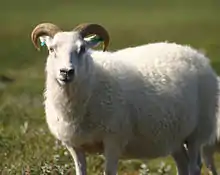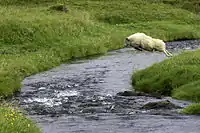Icelandic sheep
The Icelandic sheep (Icelandic: íslenska sauðkindin) is a breed of domestic sheep. The Icelandic breed is one of the Northern European short-tailed sheep, which exhibit a fluke-shaped, naturally short tail. The Icelandic is a mid-sized breed, generally short-legged and stocky, with face and legs free of wool. The fleece of the Icelandic sheep is dual-coated and occurs in white and a variety of other colors, including a range of browns, grays, and blacks. They exist in both horned and polled strains. Generally left unshorn for the winter, the breed is very cold-hardy. Multiple births are very common in Icelandic ewes, with a lambing percentage of 175–220%. A gene also exists in the breed called the Þoka gene, and ewes carrying it have been known to give birth to triplets, quadruplets, quintuplets, and even sextuplets on occasion.
 Icelandic sheep | |
| Conservation status |
|
|---|---|
| Country of origin | Iceland |
| Use | Meat, wool |
| Traits | |
| Wool color | White |
| Horn status | Horned and polled strains |
| |
Ewes can be mated as lambs as early as five to seven months, although many farmers wait until the ewe's second winter before allowing them to breed. They are seasonal breeders and come into estrus around October. The breeding season can last up to four months. Rams become mature early and can start breeding as early as five months.
Descended from the same stock as the Norwegian Spelsau, brought to Iceland by the first settlers, Icelandic sheep have been bred for a thousand years in a very harsh environment. Consequently, they are quite efficient herbivores.
Color genetics
The colors of Icelandic sheep are inherited in a similar way to those of other sheep, but they display more variety in color and pattern than most other breeds, and some variations are seen which are not seen in other sheep. Each sheep carries three genes that affect the color of the sheep, and each gene has dominant and recessive alleles. Each lamb receives one allele from each parent of each of the genes shown below.[2][3]
| Locus | Gene name | Dominant alleles | Recessive alleles |
|---|---|---|---|
| B | Base color | black | brown (moorit) |
| A (agouti gene) | Pattern | white (gray, badgerface, mouflon) | (gray, badgerface, mouflon) solid |
| S | Spotting | no spotting | spotting |
Color

The base color of all Icelandic sheep is either black or moorit (brown), each in a variety of shades and tones. Black is the dominant allele. The appearance of these colors can be altered by patterns and spotting.
Pattern
Six patterns alleles are seen in the breed. The most dominant pattern of these is white, which conceals any other pattern, color, or spotting that may be present, producing a solid white sheep.
Several other patterns change the appearance of the color the animal shows. One of these is gray, which, together with the base color gene, will give rise to either gray black or gray moorit. Another is "badgerface", which shows as lighter coloration on the back, sides, neck, ears, and face, with a darker color on the underbelly, under the tail, parts of the neck, and around the eyes. Once again, this pattern shows as either grey badgerface or moorit badgerface. A further pattern is "mouflon". These sheep are light-colored where badgerface sheep are dark, and dark where badgerface sheep are light.
The gray, badgerface, and mouflon patterns are equally dominant. A sheep can display any of these patterns individually, or can display two of them at the same time. Sheep carrying both badgerface and mouflon show as plain-coloured sheep with slightly darker markings where the two patterns meet.
Also, a single allele recently appeared in a US flock (it was formerly known only in Iceland, and was rare there), which displays as gray-mouflon; it is separate from the normal mouflon pattern. This gray-mouflon allele is dominant to solid, recessive to white, and co-dominant with gray, badgerface, and mouflon.
The least dominant pattern is solid, which is essentially no pattern at all. Solid-patterned animals simply show their base color all over. To be solid, a sheep must inherit the solid pattern from both parents – the parents could be solid themselves, or they could carry a solid allele hidden by another other pattern allele.
White sheep can also carry any one of the five other patterns, but it is hidden by the dominant white color (white in sheep is genetically a pattern, not a color).
Spotting
This gene gives rise to white markings on the feet, face, head, or over large parts of the body. The unspotted areas may be any of the patterns and colors described above.
Two alleles for spotting are seen: spotted and unspotted; unspotted is dominant. Only when bearing two spotting alleles does the sheep display spotting.
Meat production
In Iceland, this breed is mostly bred for meat.[4] Lambs are not fed grain or given hormones. The lambs are ready for killing by four to five months, when they weigh 70 to 90 pounds (32 to 41 kg). The meat has a fine grain and distinct, delicate flavor. The meat of the Icelandic sheep is considered a gourmet style of meat.
Fiber



Icelandic fleece is dual-coated. In Icelandic, the long outer coat is called tog and the fine inner coat þel. When separated, the outer and inner coats are used for different woolen products.
Tog
Tog is generally classified as a medium wool around 27 micrometers in diameter. It is good for weaving and other durable products.
Gel
Gel, being the finer wool and classified as such, is generally around 20 micrometers in diameter. This fine wool is used for garments that touch the skin.
Tog and þel are processed together to produce lopi, a distinctive knitting wool that is only made from the fleece of Icelandic sheep.
Milk
Until the 1940s, Icelandic sheep were the predominant milk producing animal in Iceland.[5] Sheep are not milked in Iceland today, and instead the lamb is allowed to continue suckling. This is largely due to the increased ease of raising cattle in Iceland since the development of mechanized haying.[6]
Traditionally, after the first two weeks of life, the lambs were weaned off the mother's milk. Then for the next six weeks, the ewes were milked daily. Most provided about 1 litre (2 imp pt) of milk per day, while good ewes gave 2 litres (4 imp pt) to 3 litres (5 imp pt). The milk was used directly, or made into butter, cheese, an Icelandic soft cheese called skyr, or naturally sweet yogurt.[6]
References
- Barbara Rischkowsky, D. Pilling (eds.) (2007). pg 137. List of breeds documented in the Global Databank for Animal Genetic Resources, annex to The State of the World's Animal Genetic Resources for Food and Agriculture. Rome: Food and Agriculture Organization of the United Nations. ISBN 9789251057629. Accessed August 2017.
- An attempt to determine the pattern of inheritance of coat colors in hair sheep. Livestock Research for Rural Development, Vol. 16, Art. #6. Archived 2007-09-28 at the Wayback Machine Saldaña-Muñoz V R, Torres-Hernández G, González-Camacho J M, Díaz-Rivera P, González-Garduño R and Rubio-Rubio M 2004: Retrieved August 2, 2006
- Susan Mongold. "Color Genetics in Icelandic Sheep". Archived from the original on 2009-03-23. Retrieved 2009-04-07.
- "Icelandic". Breeds of Livestock. Oklahoma State University, Dept. of Animal Science. Archived from the original on 2009-02-23. Retrieved 2009-04-17.
- Tyne, Tim (2009). The sheep book for smallholders. Preston [England]: Good Life Press. ISBN 9781904871644.
- Mongold, Susan. "Icelandic Sheep as a Dairy Animal" (PDF). Icelandic Sheep Breeders of North America. Icelandic Sheep Breeders of North America. Retrieved 28 May 2017.
External links
| Wikimedia Commons has media related to Icelandic sheep. |